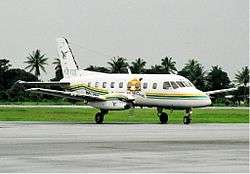Air Fiji Flight 121
 An Air Fiji Embraer EMB 110 Bandeirante similar to the accident aircraft | |
| Accident summary | |
|---|---|
| Date | 24 July 1999 |
| Summary | Intoxication, pilot error |
| Site | Nasevou village, Delailasakau, Fiji |
| Passengers | 15 (including 1 infant) |
| Crew | 2 |
| Fatalities | 17 (all) |
| Injuries (non-fatal) | 0 |
| Survivors | 0 |
| Aircraft type | Embraer EMB 110 Bandeirante |
| Operator | Air Fiji |
| Registration | DQ-AFN |
| Flight origin | Nausori International Airport, Suva, Fiji |
| Destination | Nadi International Airport, Nadi, Fiji |
Air Fiji Flight 121 (PC121/FAJ121) was a scheduled domestic passenger flight from Nausori International Airport in Fiji's capital Suva to Nadi International Airport in Viti Levu, Nadi, operated by an Embraer EMB 110 Bandeirante. On 24 July 1999, the EMB 110 carrying 17 people consisting of 15 passengers and 2 crews slammed into a mountain near Delailasakau while en route to Nadi. The crash killed all 17 people on board. Flight 121 remains as the deadliest plane crash in Fiji history, surpassing the previous crash of Sunflower Airlines de Havilland Heron on 27 December 1986, killing all 11 people on board.[1]
Accident
The Embraer EMB 110 took off from Nausori with 17 passengers and crews. The aircraft was carrying nine Fijians, five Australians, one New Zealander, one Chinese and one Japanese.[2] 15 minutes after take off from Nausori International Airport, the aircraft slammed into the mountainside near Delailasakau, shortly after dawn.[3] Radio contact was lost with the aircraft. At about 08:40 or twenty minutes to nine, police had a call from the radio telephone operator from Windina to say that they heard a loud crash out in the hills, north of Nasevou village. Witnesses stated that they saw the aircraft was flying low, and shortly after slammed into the mountainside. One man stated that he heard a "cannonball" during the crash. He then saw parts from the tail fall down. [4]
A search team was dispatched by the authorities. Shortly after, a helicopter spotted the wreckage of Flight 121. There were no signs of life on the crash site.[5] Most bodies were severely mutilated, with witnesses describing many internal organs spread throughout the crash site. The area of the crash site was a remote area, forcing the rescuers to evacuate the bodies only by foot. The crash site is about six hours' walk from the nearest village, with few roads and no telephone links. Police operations director Jahir Khan said police would try to remove the bodies by 25 July. Lack of equipment hampered the evacuation process and several bodies were trapped in the wreckage had to be evacuated by cutting and removing the wreckage from the area.[6]
Aircraft
The aircraft involved in the crash was an Embraer EMB 110 ( MSN 110416) registered in Fiji as DQ-AFN. Powered by two Pratt & Whitney Canada PT6A-34 turboprop engines AFN was first flown in 1983 and had flown a total of 22411 cycles. The aircraft was registered in America and Australia prior to being operated by Air Fiji.[7]
Investigation
The Civil Aviation Authority of Fiji (CAAF) investigated the crash of Flight 121, with assistance from the Australia's AAIB. Interviews conducted by the CAAF found that witnesses stated that before crashing, parts of the tail and wings fell down onto the forest, indicating a possible structural failure. The tail fin and horizontal stabilisers were found 300 m (980 ft) to the left of the line of flight. This was consistent with a pre-impact structural failure, meaning that the aircraft may have broken up in the air before crashing to the ground. Specific investigations later found that the pilot of Flight 121 may have been intoxicated. The brother of the pilot stated that 4 hour before the crash the captain of the flight had been drinking alcohol.[8] Investigation also revealed that the captain had insufficient rest prior to the flight and that he had consumed an above-therapeutic level of antihistamine prior to the flight. Air Fiji's Standard Operating Procedure was also found to be inadequate.
The structural failure that occurred in flight was a result from the crew's error in descending below the Minimum Descent Altitude of 1,600 m (5,400 ft). The right wing struck a ridge at 400 m (1,300 ft), the aircraft then broke up and impacted the slope of a ridge 1.3 km (0.81 mi) further on. The tail section and right wing were found 150 m (490 ft) from the main wreckage.[9]
See also
References
- ↑ "Air Fiji Flight 121". Aviation Safety Network.
- ↑ Keith-Reid, Robert. "PLANE CRASH IN FIJI KILLS 17". APdate=24 July 1999. Retrieved 5 November 2016.
- ↑ "17 killed in Fiji plane crash". Amarillo. 24 July 1999. Retrieved 5 November 2016.
- ↑ "FIJI: AIR FIJI PLANE CRASH". AP Archive. 24 July 1999. Retrieved 5 November 2016.
- ↑ "Fiji plane crash kills 17". 24 July 1999. Retrieved 5 November 2016.
- ↑ "FIJI: PLANE CRASH UPDATE". AP Archive. 24 July 1999. Retrieved 5 November 2016.
- ↑ "REGISTRATION DETAILS FOR DQ-AFN (AIR FIJI) -". Planelogger.
- ↑ "Drinking alleged before Fiji crash". Flight Global. 9 August 1999. Retrieved 5 November 2016.
- ↑ "Air Fiji Flight 121". Aviation Safety Network.